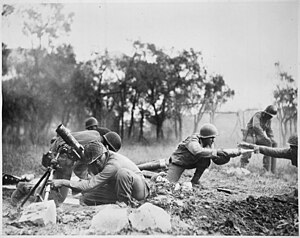

| M1 Mortar | |
|---|---|

| |
| Type | Infantry mortar |
| Place of origin | United States |
| Service history | |
| In service | 1935–1952[1] |
| Used by | United States Vietnam Other users |
| Wars | World War II Korean War Algerian War[2] Vietnam War |
| Specifications | |
| Mass | see general data |
| Length | 3 ft 11 in (1.19 m) |
| Crew | 8 (squad leader, gunner, assistant gunner, 5 ammunition bearers) |
| Shell | see ammunition |
| Caliber | 81 mm (3.2 in) |
| Rate of fire | 18 rpm sustained 30-35 rpm maximum |
| Muzzle velocity | 700 ft/s (210 m/s) |
| Maximum firing range | 3,300 yd (3,000 m) |
| Sights | M4 |
The M1 mortar is an American 81 millimeter caliber mortar. It was based on the French Brandt mortar. The M1 mortar was used from before World War II until the 1950s when it was replaced by the lighter and longer ranged M29 mortar.
Weight:
The M1 Mortar's shells sometimes used the same fuzes as the shells for the M2 60 mm mortar. An adapter collar was added to the smaller fuzes to allow them to fit the larger shells.
It may be found in nearly all the non-Communist countries,[3] including:
|
United States artillery of World War II
| |
|---|---|
| Tank guns |
|
| Anti-tank guns |
|
| Field, medium and heavy guns |
|
| Mortars |
|
| Other vehicle-mounted |
|
| Anti-aircraft guns |
|
| Coast artillery guns |
|
| Railway artillery |
|